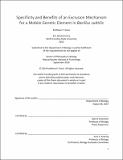Specificity and benefits of an exclusion mechanism for a mobile genetic element in Bacillus subtilis
Author(s)
Davis, Kathleen P.(Kathleen Patricia)
Download1141857431-MIT.pdf (5.707Mb)
Other Contributors
Massachusetts Institute of Technology. Department of Biology.
Advisor
Alan D Grossman.
Terms of use
Metadata
Show full item recordAbstract
The horizontal transfer of mobile genetic elements, including Integrative and Conjugative Elements (ICEs), plays an essential role in bacterial evolution by helping to promote the spread of genes involved in antibiotic and heavy metal resistance, metabolism, symbiosis, and pathogenicity. Like conjugative plasmids, ICEs spread to new hosts by conjugative transfer through Type 4 Secretion Systems (T4SSs) encoded in the ICE DNA, however unlike plasmids, ICEs are usually found integrated into the host chromosome except for immediately prior to, during and after conjugative transfer. Almost all plasmids and some ICEs have an exclusion mechanism, which prevents acquisition of a second copy of the element via conjugative transfer. ICEBs1 has an exclusion mechanism in which the ICEBs1 exclusion protein YddJ targets the conjugation machinery protein ConG, the VirB6 homolog in the ICEBs1 T4SS, to prevent transfer from a would-be donor cell. My work described in this thesis involves a mutagenesis and enrichment screen which isolated exclusion-resistant, transfer-competent mutations in ConG, and swap experiments with ICEBs1 and ICEBat1 ConG and YddJ homologs demonstrating that YddJ targets its cognate ConG for exclusion, and that YddJ and ConG together determine the specificity of exclusion. I identified regions of ConG and YddJ that are essential for exclusion specificity, and found that YddJ-mediated exclusion protects donor cells from serving as recipients during or immediately after they serve as donors. These findings further our understanding of regulation of horizontal gene transfer, particularly in Gram-positive bacteria. They provide further evidence of a conserved target in exclusion, the VirB6 homologs, and indicate that different mobile genetic elements can employ exclusion systems for different reasons.
Description
This electronic version was submitted by the student author. The certified thesis is available in the Institute Archives and Special Collections. Thesis: Ph. D., Massachusetts Institute of Technology, Department of Biology, 2019 Cataloged from student-submitted PDF version of thesis. Includes bibliographical references.
Date issued
2019Department
Massachusetts Institute of Technology. Department of BiologyPublisher
Massachusetts Institute of Technology
Keywords
Biology.